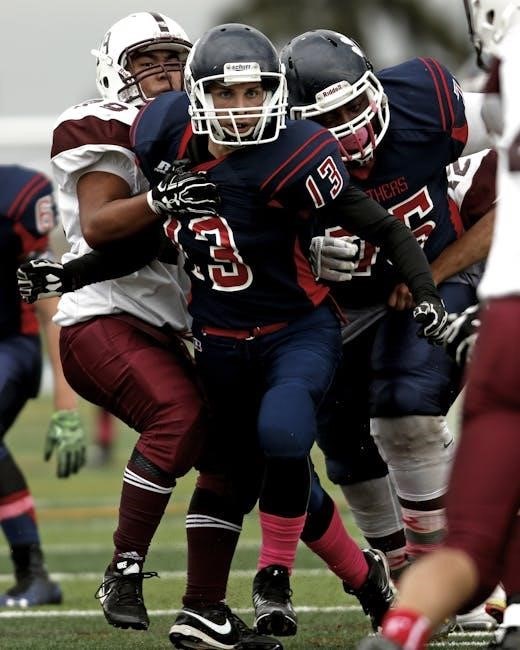Linear Algebra Done Wrong: A Comprehensive Overview
Linear Algebra Done Wrong is a set of lecture notes for advanced students. It’s an honors-level first course, emphasizing proofs and geometric concepts over computational procedures. The book aims to provide a rigorous foundation for those pursuing pure mathematics or theoretical physics, focusing on conceptual understanding.
Linear Algebra Done Wrong (LADW) by Sergei Treil presents a unique approach to the subject. Unlike traditional textbooks, LADW prioritizes theoretical understanding and rigorous proofs over rote memorization of computational techniques. It originated as lecture notes for an honors-level linear algebra course designed for mathematically advanced students. The title itself hints at its unconventional nature, prompting curiosity about what makes it different. LADW emphasizes grasping the underlying geometric concepts. This approach aids students aiming for advanced studies in mathematics or physics. It prepares them for abstract reasoning and problem-solving.
The text encourages a deeper understanding of linear algebra’s foundations. This focus contrasts with methods solely focused on calculation. The book aims to develop the student’s ability to think abstractly and construct mathematical arguments. No official solution manual is available online, increasing the challenge for self-learners. Students must engage with the material more deeply. LADW intends to provide a solid foundation for further exploration. It presents linear algebra as a tool for theoretical exploration.
Target Audience and Prerequisites
Linear Algebra Done Wrong is primarily intended for mathematically advanced students. These students are typically enrolled in honors-level courses or have a strong interest in theoretical mathematics or physics. The book assumes a certain level of mathematical maturity and familiarity with proof-based mathematics. While not explicitly requiring prior knowledge of linear algebra, a solid foundation in pre-calculus and basic mathematical reasoning is highly recommended. Students should be comfortable with abstract concepts and be prepared to engage in rigorous mathematical arguments.
The text is designed for those who want to go beyond the computational aspects of linear algebra and delve into its theoretical underpinnings. It is suitable for students who plan to pursue further studies in mathematics, physics, or related fields where a deep understanding of linear algebra is essential. Linear Algebra Done Wrong is not recommended for students who are primarily interested in learning computational techniques for solving practical problems. It is geared towards those who seek a more abstract and theoretical perspective on the subject. A willingness to embrace abstraction and engage with proofs is crucial for success with this text.
Key Concepts Emphasized in LADW
Linear Algebra Done Wrong places significant emphasis on understanding the underlying theoretical concepts of linear algebra. Unlike traditional approaches that focus on computational techniques, this text prioritizes a deep comprehension of the abstract ideas and their interrelationships. One of the key concepts highlighted is the geometric interpretation of linear algebra. The book stresses the importance of visualizing linear transformations, vector spaces, and other concepts geometrically, rather than simply manipulating coordinates.
Another crucial aspect emphasized in LADW is the role of proofs in establishing mathematical truths. Students are expected to engage with rigorous proofs and develop their ability to construct their own arguments. The text also delves into topics such as vector spaces, linear transformations, eigenvalues, eigenvectors, and inner product spaces, all while maintaining a focus on the underlying theoretical framework. Furthermore, LADW underscores the significance of understanding the limitations and potential pitfalls of various linear algebra techniques. By emphasizing these key concepts, the book aims to provide students with a solid foundation for further study in mathematics and related fields.
Geometric Interpretation in LADW
Linear Algebra Done Wrong strongly emphasizes the geometric interpretation of linear algebra concepts, advocating for a visual and intuitive understanding over rote memorization of computational procedures. This approach aims to foster a deeper comprehension of the subject matter by connecting abstract algebraic concepts to concrete geometric representations. Students are encouraged to visualize vector spaces as geometric objects, linear transformations as mappings between these spaces, and eigenvalues/eigenvectors as indicators of how transformations scale and rotate vectors.
The text promotes understanding linear transformations by visualizing their effects on vectors and spaces. Rather than focusing solely on matrix manipulations, students are guided to see how transformations stretch, shear, rotate, and reflect vectors in space. This geometric perspective allows for a more intuitive grasp of concepts like determinants, which can be understood as scaling factors of volumes under linear transformations. By prioritizing geometric reasoning, LADW equips students with a powerful tool for problem-solving and a richer understanding of the fundamental principles of linear algebra, moving beyond mere symbol manipulation to genuine conceptual mastery.
Comparison with “Linear Algebra Done Right”
While both “Linear Algebra Done Wrong” (LADW) and “Linear Algebra Done Right” (LADR) aim for a more theoretical approach, they cater to slightly different audiences and emphasize different aspects of the subject. LADR is often recommended for students intending to pursue pure mathematics or theoretical physics, providing a solid foundation in the abstract concepts of linear algebra. LADW, on the other hand, takes an even more rigorous approach, potentially targeting students with a stronger mathematical background or those in honors-level courses.
A key difference lies in the problem-solving approach. LADR typically covers a significant portion of standard linear algebra topics, equipping students with techniques applicable in various contexts. LADW prioritizes conceptual understanding and proof-writing skills, potentially sacrificing breadth for depth. While LADR has available solutions, LADW lacks an official solution manual, emphasizing independent problem-solving and critical thinking. Ultimately, the choice between the two depends on the student’s mathematical maturity, learning style, and specific goals.
Availability of Solutions and Solution Manuals
A significant challenge for self-learners using “Linear Algebra Done Wrong” (LADW) is the absence of an officially published solution manual. Unlike some textbooks, including its counterpart “Linear Algebra Done Right,” LADW does not offer readily available solutions to its exercises. This lack of official solutions can make self-study and revision difficult, as students may struggle to verify their understanding and identify errors in their work.
However, resourceful students have attempted to address this gap; Some individuals have created and shared unofficial solutions to LADW exercises online. These solutions, often found in repositories, can provide valuable guidance. However, users must exercise caution, as these unofficial solutions may contain errors or typos. It’s crucial to critically evaluate the provided solutions and compare them with one’s own reasoning. The absence of official solutions encourages independent problem-solving and deep engagement with the material but requires extra diligence.
Common Topics Covered in LADW
“Linear Algebra Done Wrong” (LADW) delves into fundamental linear algebra topics, providing a rigorous treatment suitable for mathematically advanced students. The text typically covers vector spaces, exploring their properties and structures in depth. Linear transformations are another core focus, examining their mapping characteristics and representations.
The book also addresses matrices, determinants, and systems of linear equations, offering a more theoretical perspective compared to introductory texts. Eigenvalues and eigenvectors are thoroughly discussed, highlighting their significance in various applications. Furthermore, LADW delves into topics like inner product spaces, orthogonality, and the spectral theorem, crucial for understanding advanced concepts. While a standard linear algebra course might cover 70-80% of these topics, LADW aims to provide a comprehensive and proof-oriented exploration. It emphasizes conceptual understanding, fostering a deeper appreciation for the underlying mathematical principles.
Advantages of Using LADW
One significant advantage of using “Linear Algebra Done Wrong” (LADW) lies in its emphasis on conceptual understanding and rigorous proofs. This approach fosters a deeper appreciation for the underlying mathematical principles, moving beyond mere computational proficiency. LADW is particularly beneficial for students aiming for advanced studies in mathematics, theoretical physics, or related fields, where a strong theoretical foundation is crucial.
The book’s focus on geometric concepts helps visualize abstract ideas, making them more intuitive and accessible. It also prepares students for more advanced mathematical reasoning and proof-writing. Furthermore, LADW encourages independent thinking and problem-solving skills, as students are challenged to understand and construct their own proofs. The comprehensive coverage of topics ensures students are well-prepared for subsequent courses, equipping them with the necessary tools to tackle complex mathematical challenges. Its rigorous approach helps develop mathematical maturity and a deeper understanding of linear algebra’s role in various scientific disciplines.
Criticisms and Potential Drawbacks
Despite its strengths, “Linear Algebra Done Wrong” (LADW) has potential drawbacks. Its theoretical focus might overwhelm students primarily interested in applications or those with limited mathematical backgrounds. The lack of a readily available solution manual can hinder self-study, making it challenging for independent learners to verify their solutions and overcome difficulties. The book’s emphasis on proofs may also deter students seeking a more computational approach to linear algebra.
Furthermore, the rigor of LADW might make it less accessible for students who are not mathematically inclined or who prefer a more intuitive presentation of the material. The abstract nature of the concepts covered could also lead to frustration if not complemented by practical examples or real-world applications. Some learners may find the pace too fast or the exercises too challenging, requiring additional resources or support to fully grasp the concepts. Therefore, it is essential to consider one’s mathematical background and learning style before committing to LADW.
Resources for Further Learning
To supplement “Linear Algebra Done Wrong” (LADW), various resources can enhance understanding and provide alternative perspectives. “Linear Algebra Done Right” by Sheldon Axler offers a complementary approach, focusing on abstraction without determinants. Online platforms like Khan Academy and MIT OpenCourseWare provide video lectures and practice problems covering linear algebra topics. Textbooks such as Gilbert Strang’s “Linear Algebra and Its Applications” offer a more applied perspective.
Additionally, websites like Stack Exchange and MathOverflow can be valuable for seeking clarification on specific concepts or problem-solving strategies. For those seeking solutions, although no official manual exists for LADW, some student-generated solutions are available online; however, exercise caution and verify for accuracy. Consider exploring interactive linear algebra tools and visualizations to develop geometric intuition. Collaboration with peers and instructors can also be invaluable. Remember to tailor your resource selection to your learning style and specific areas needing reinforcement.



Be the first to reply